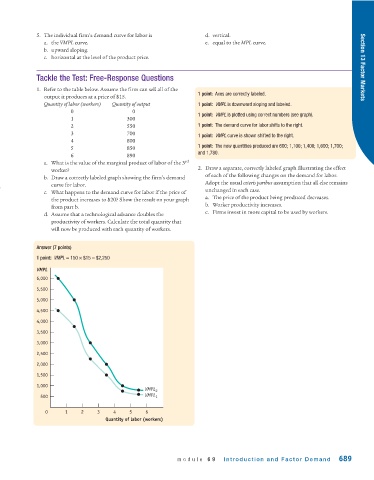Page 731 - Krugmans Economics for AP Text Book_Neat
P. 731
5. The individual firm’s demand curve for labor is d. vertical.
a. the VMPL curve. e. equal to the MPL curve.
b. upward sloping.
c. horizontal at the level of the product price.
Tackle the Test: Free-Response Questions Section 13 Factor Markets
1. Refer to the table below. Assume the firm can sell all of the
1 point: Axes are correctly labeled.
output it produces at a price of $15.
Quantity of labor (workers) Quantity of output 1 point: VMPL is downward sloping and labeled.
0 0
1 point: VMPL is plotted using correct numbers (see graph).
1 300
2 550 1 point: The demand curve for labor shifts to the right.
3 700 1 point: VMPL curve is shown shifted to the right.
4 800
5 850 1 point: The new quantities produced are 600; 1,100; 1,400; 1,600; 1,700;
and 1,780.
6 890
a. What is the value of the marginal product of labor of the 3 rd
worker? 2. Draw a separate, correctly labeled graph illustrating the effect
b. Draw a correctly labeled graph showing the firm’s demand of each of the following changes on the demand for labor.
curve for labor. Adopt the usual ceteris paribus assumption that all else remains
c. What happens to the demand curve for labor if the price of unchanged in each case.
the product increases to $20? Show the result on your graph a. The price of the product being produced decreases.
from part b. b. Worker productivity increases.
d. Assume that a technological advance doubles the c. Firms invest in more capital to be used by workers.
productivity of workers. Calculate the total quantity that
will now be produced with each quantity of workers.
Answer (7 points)
1 point: VMPL = 150 × $15 = $2,250
VMPL
6,000
5,500
5,000
4,500
4,000
3,500
3,000
2,500
2,000
1,500
1,000
VMPL 2
500 VMPL 1
0 1 2 3 4 5 6
Quantity of labor (workers)
module 69 Introduction and Factor Demand 689

